LONDON — The world is set to use up three quarters of a theoretical carbon budget that would limit global warming to safe levels within 15 years, the United Nations said.
The world will pump out 748 gigatons of carbon dioxide from 2012 through 2030, the world body said Friday in a report that analyzed emissions pledges by 146 nations. Exceeding 1,000 gigatons means the world risks a temperature increase since preindustrial times of more than 2 degrees Celsius (35.6 degrees Fahrenheit). Beyond that, scientists say the effects of global warming — including melting ice caps, rising seas and stronger storms — may become unmanageable.
The pledges will be included in a deal that 195 nations aim to seal in Paris in December, for the first time binding all countries to limit their emissions. While the aggregate falls short of the targeted 2-degree cap on temperatures, the U.N. said it provides a foundation to build from.
The pledges “represent a clear and determined down-payment on a new era of climate ambition from the global community of nations,” Christiana Figueres, U.N. Framework Convention on Climate Change executive secretary, said in a statement. “These plans together begin to make a significant dent in the growth of greenhouse gas emissions: As a floor, they provide a foundation upon which ever higher ambition can be built.”
Envoys at the talks are debating including a “ratchet” or “ambition” mechanism that means countries would periodically revisit their pledges with a view to increasing their carbon-reduction efforts.
While the U.N. report itself didn’t include a calculation for what temperature trajectory the national climate plans put the planet on, Ms. Figueres said they could limit the temperature rise by 2100 to 2.7 degrees Celsius, an improvement on previous estimates of 4 degrees to 5 degrees.
‘Right direction’
“While this round of pledges is a step in the right direction, they only take us from a 4-degree catastrophe to a 3-degree disaster,” said Tim Gore, head of climate policy at the development charity Oxfam.
The UN analyzed plans received by Oct. 1 from nations accounting for 86 percent of greenhouse gases. Because not all plans included every sector of the economy, coverage was about 80 percent of global emissions, it said. Together, they would slash emissions in 2030 by 3.6 billion tons in 2030. That’s roughly equivalent to eliminating the annual emissions of Russia, Germany and the U.K.
Even so, many of the plans include reductions from a “business as usual scenario” that would still allow emissions to rise over the next 15 years. Total annual global emissions would rise to 56.7 gigatons in 2030 from 48.1 gigatons in 2010, the U.N. said. Because of population growth, per-capita emissions in 2030 would decline by 5 percent from 2010 levels, an indication of more efficient economies.
First Published: October 31, 2015, 3:30 a.m.















